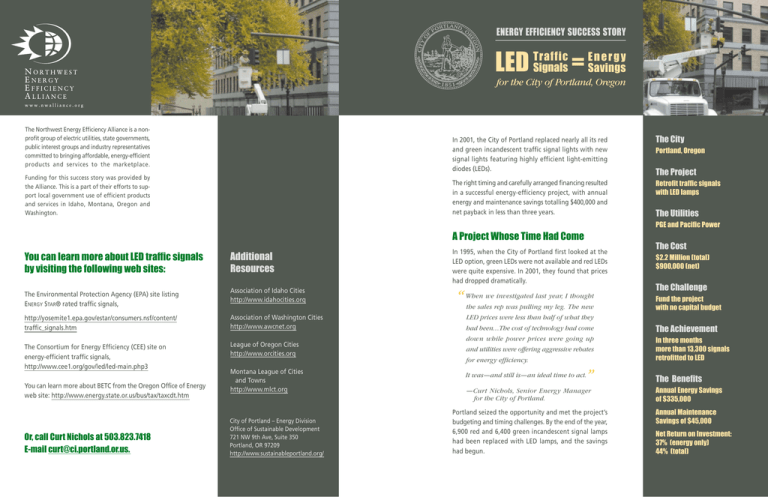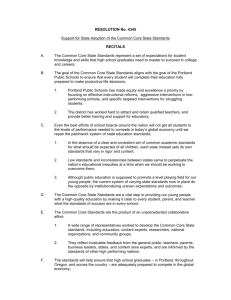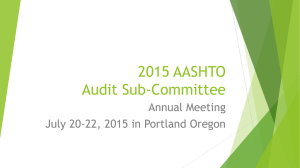LED Traffic Signals=Energy Saving
advertisement

ENERGY EFFICIENCY SUCCESS STORY LED Traffic Signals = Energy Savings for the City of Portland, Oregon The Northwest Energy Efficiency Alliance is a nonprofit group of electric utilities, state governments, public interest groups and industry representatives committed to bringing affordable, energy-efficient products and services to the marketplace. In 2001, the City of Portland replaced nearly all its red and green incandescent traffic signal lights with new signal lights featuring highly efficient light-emitting diodes (LEDs). Funding for this success story was provided by the Alliance. This is a part of their efforts to support local government use of efficient products and services in Idaho, Montana, Oregon and Washington. The right timing and carefully arranged financing resulted in a successful energy-efficiency project, with annual energy and maintenance savings totalling $400,000 and net payback in less than three years. The City Portland, Oregon The Project Retrofit traffic signals with LED lamps The Utilities PGE and Pacific Power A Project Whose Time Had Come You can learn more about LED traffic signals by visiting the following web sites: The Environmental Protection Agency (EPA) site listing ENERGY STAR® rated traffic signals, http://yosemite1.epa.gov/estar/consumers.nsf/content/ traffic_signals.htm The Consortium for Energy Efficiency (CEE) site on energy-efficient traffic signals, http://www.cee1.org/gov/led/led-main.php3 You can learn more about BETC from the Oregon Office of Energy web site: http://www.energy.state.or.us/bus/tax/taxcdt.htm Or, call Curt Nichols at 503.823.7418 E-mail curt@ci.portland.or.us. Additional Resources Association of Idaho Cities http://www.idahocities.org Association of Washington Cities http://www.awcnet.org League of Oregon Cities http://www.orcities.org Montana League of Cities and Towns http://www.mlct.org City of Portland – Energy Division Office of Sustainable Development 721 NW 9th Ave, Suite 350 Portland, OR 97209 http://www.sustainableportland.org/ In 1995, when the City of Portland first looked at the LED option, green LEDs were not available and red LEDs were quite expensive. In 2001, they found that prices had dropped dramatically. “ When we investigated last year, I thought the sales rep was pulling my leg. The new The Cost $2.2 Million (total) $900,000 (net) The Challenge Fund the project with no capital budget LED prices were less than half of what they had been. . . The cost of technology had come The Achievement down while power prices were going up In three months more than 13,300 signals retrofitted to LED and utilities were offering aggressive rebates for energy efficiency. ” It was—and still is—an ideal time to act. The Benefits —Curt Nichols, Senior Energy Manager for the City of Portland. Annual Energy Savings of $335,000 Portland seized the opportunity and met the project’s budgeting and timing challenges. By the end of the year, 6,900 red and 6,400 green incandescent signal lamps had been replaced with LED lamps, and the savings had begun. Annual Maintenance Savings of $45,000 Net Return on Investment: 37% (energy only) 44% (total) LED Project Figures environment and save taxpayer money at the same time. These LED lamps are clearly superior to traditional incandescent lights in terms of energy efficiency, and that translates directly into reduced impacts on wildlife habitat and global warming emissions. With $335,000 in annual utility bill savings, this investment will pay back multiple benefits for the City for years to come. Savings Liability 4% Maintenance 8% ” Energy 70% — Dan Saltzman Portland City Commissioner Paul Zebell, signal operations specialist, holds an incandescent bulb and an LED replacement module. A Challenge and a Solution A City-hired contractor installs one of more than 13,000 LED lamps during the fall of 2001. Three factors brought a sense of urgency to the LED project: Portland's LED retrofit • The energy crisis facing the Western states. • 6,900 red and 6,400 green signal lamps (a mix of 12” balls, 8” balls, and turn arrows in both colors.) • Significant electric rate increases in October 2001. • Special incentives that two local electric utilities, PGE and Pacific Power, were offering for energy efficiency projects completed before 2002. Leasing + Incentives + Tax Credit Benefits = Major Savings for the City Even at the new lower LED prices, retrofitting Portland's traffic signals would cost about $2.2 million. The City didn’t have capital allocated for a project of that size. A leasing arrangement provided the solution. First, leasing spread the capital costs out to more closely match the energy and maintenance savings of the retrofit. Second, the terms of the lease allowed the City to use contract labor to complete the project before the end of 2001, and thus claim rebates from PGE and Pacific Power totalling $715,000. Third, the lease option also allowed the City to benefit from Oregon’s Business Energy Tax Credit (BETC). Although the City doesn’t pay income taxes, it can still benefit from tax credits through an arrangement where the tax credit taken by the leasing company can be shared with the other party. The BETC tax credit—worth 35 percent of an energy project’s total cost—made the lease option even more attractive. In Portland’s LED project, the leasing company gets a 35 percent tax credit taken over time, reducing the cost of the City's lease by about 22 percent, saving the City nearly $500,000. “T he LEDs have reduced transportation maintenance costs by $45,000 a year in off-hour call out costs and replacement bulbs. LED modules have a life of six years or more while the current bulbs have only a two-year life. In addition, we've been able to save 1,400 hours of valuable staff time per year previously used for group relamping and apply that time to other maintenance needs. ” — Bill Kloos Portland Signals and Streetlighting Manager the only Energ y isn’t e saving! thing we ar Energy Usage Comparison • 140 flashing amber beacons • several light rail transit signals STANDARD INCANDESCENT . . .and its benefits ENERGY-SAVING INCANDESCENT LED A Energy use and savings BEFORE Kilowatt hours per year Electric cost per year $420,000 Maintenance costs per year Savings LED C AFTER 0 50 $85,000 100 150 L A M P W AT TA G E 200 Net Cashflow $335,000 8 Maintenance savings Average lamp life gs Huge savin ED! with any L LED B 6.1 million 1.2 million Energy savings per year Note: Since the completion of this project, the State of Oregon has revised its administrative rules to allow the sharing of tax credits without a lease arrangement. Today, any equipment supplier or installation contractor can provide a tax credit “pass-through” equal to 27 percent of the project’s cost. Relamping 18% BEFORE AFTER ~2 years ~6 years $60,000 $15,000 SAVINGS IN $100,000’s “ It's a good thing when City Government can help protect the 7 Positive cashflow ear! the first y 6 5 4 3 2 1 0 $45,000 1 2 3 4 5 YEARS 6 7 LED Project Figures environment and save taxpayer money at the same time. These LED lamps are clearly superior to traditional incandescent lights in terms of energy efficiency, and that translates directly into reduced impacts on wildlife habitat and global warming emissions. With $335,000 in annual utility bill savings, this investment will pay back multiple benefits for the City for years to come. Savings Liability 4% Maintenance 8% ” Energy 70% — Dan Saltzman Portland City Commissioner Paul Zebell, signal operations specialist, holds an incandescent bulb and an LED replacement module. A Challenge and a Solution A City-hired contractor installs one of more than 13,000 LED lamps during the fall of 2001. Three factors brought a sense of urgency to the LED project: Portland's LED retrofit • The energy crisis facing the Western states. • 6,900 red and 6,400 green signal lamps (a mix of 12” balls, 8” balls, and turn arrows in both colors.) • Significant electric rate increases in October 2001. • Special incentives that two local electric utilities, PGE and Pacific Power, were offering for energy efficiency projects completed before 2002. Leasing + Incentives + Tax Credit Benefits = Major Savings for the City Even at the new lower LED prices, retrofitting Portland's traffic signals would cost about $2.2 million. The City didn’t have capital allocated for a project of that size. A leasing arrangement provided the solution. First, leasing spread the capital costs out to more closely match the energy and maintenance savings of the retrofit. Second, the terms of the lease allowed the City to use contract labor to complete the project before the end of 2001, and thus claim rebates from PGE and Pacific Power totalling $715,000. Third, the lease option also allowed the City to benefit from Oregon’s Business Energy Tax Credit (BETC). Although the City doesn’t pay income taxes, it can still benefit from tax credits through an arrangement where the tax credit taken by the leasing company can be shared with the other party. The BETC tax credit—worth 35 percent of an energy project’s total cost—made the lease option even more attractive. In Portland’s LED project, the leasing company gets a 35 percent tax credit taken over time, reducing the cost of the City's lease by about 22 percent, saving the City nearly $500,000. “T he LEDs have reduced transportation maintenance costs by $45,000 a year in off-hour call out costs and replacement bulbs. LED modules have a life of six years or more while the current bulbs have only a two-year life. In addition, we've been able to save 1,400 hours of valuable staff time per year previously used for group relamping and apply that time to other maintenance needs. ” — Bill Kloos Portland Signals and Streetlighting Manager the only Energ y isn’t e saving! thing we ar Energy Usage Comparison • 140 flashing amber beacons • several light rail transit signals STANDARD INCANDESCENT . . .and its benefits ENERGY-SAVING INCANDESCENT LED A Energy use and savings BEFORE Kilowatt hours per year Electric cost per year $420,000 Maintenance costs per year Savings LED C AFTER 0 50 $85,000 100 150 L A M P W AT TA G E 200 Net Cashflow $335,000 8 Maintenance savings Average lamp life gs Huge savin ED! with any L LED B 6.1 million 1.2 million Energy savings per year Note: Since the completion of this project, the State of Oregon has revised its administrative rules to allow the sharing of tax credits without a lease arrangement. Today, any equipment supplier or installation contractor can provide a tax credit “pass-through” equal to 27 percent of the project’s cost. Relamping 18% BEFORE AFTER ~2 years ~6 years $60,000 $15,000 SAVINGS IN $100,000’s “ It's a good thing when City Government can help protect the 7 Positive cashflow ear! the first y 6 5 4 3 2 1 0 $45,000 1 2 3 4 5 YEARS 6 7 ENERGY EFFICIENCY SUCCESS STORY LED Traffic Signals = Energy Savings for the City of Portland, Oregon The Northwest Energy Efficiency Alliance is a nonprofit group of electric utilities, state governments, public interest groups and industry representatives committed to bringing affordable, energy-efficient products and services to the marketplace. In 2001, the City of Portland replaced nearly all its red and green incandescent traffic signal lights with new signal lights featuring highly efficient light-emitting diodes (LEDs). Funding for this success story was provided by the Alliance. This is a part of their efforts to support local government use of efficient products and services in Idaho, Montana, Oregon and Washington. The right timing and carefully arranged financing resulted in a successful energy-efficiency project, with annual energy and maintenance savings totalling $400,000 and net payback in less than three years. The City Portland, Oregon The Project Retrofit traffic signals with LED lamps The Utilities PGE and Pacific Power A Project Whose Time Had Come You can learn more about LED traffic signals by visiting the following web sites: The Environmental Protection Agency (EPA) site listing ENERGY STAR® rated traffic signals, http://yosemite1.epa.gov/estar/consumers.nsf/content/ traffic_signals.htm The Consortium for Energy Efficiency (CEE) site on energy-efficient traffic signals, http://www.cee1.org/gov/led/led-main.php3 You can learn more about BETC from the Oregon Office of Energy web site: http://www.energy.state.or.us/bus/tax/taxcdt.htm Or, call Curt Nichols at 503.823.7418 E-mail curt@ci.portland.or.us. Additional Resources Association of Idaho Cities http://www.idahocities.org Association of Washington Cities http://www.awcnet.org League of Oregon Cities http://www.orcities.org Montana League of Cities and Towns http://www.mlct.org City of Portland – Energy Division Office of Sustainable Development 721 NW 9th Ave, Suite 350 Portland, OR 97209 http://www.sustainableportland.org/ In 1995, when the City of Portland first looked at the LED option, green LEDs were not available and red LEDs were quite expensive. In 2001, they found that prices had dropped dramatically. “ When we investigated last year, I thought the sales rep was pulling my leg. The new The Cost $2.2 Million (total) $900,000 (net) The Challenge Fund the project with no capital budget LED prices were less than half of what they had been. . . The cost of technology had come The Achievement down while power prices were going up In three months more than 13,300 signals retrofitted to LED and utilities were offering aggressive rebates for energy efficiency. ” It was—and still is—an ideal time to act. The Benefits —Curt Nichols, Senior Energy Manager for the City of Portland. Annual Energy Savings of $335,000 Portland seized the opportunity and met the project’s budgeting and timing challenges. By the end of the year, 6,900 red and 6,400 green incandescent signal lamps had been replaced with LED lamps, and the savings had begun. Annual Maintenance Savings of $45,000 Net Return on Investment: 37% (energy only) 44% (total)


